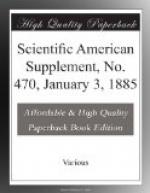M. Tresca also protests against the elongation of metals under breaking strain tests being stated as a percentage of the length. The elongation is in all cases, chiefly local; and is therefore the same for a test piece 12 inches or 8 inches long, being confined to the immediate vicinity of the point of rupture. The indication of elasticity should rather be sought for in the reduction of the area of the bar at the point of rupture. This portion of the bar is otherwise remarkable for having lost its original condition. It is condensed in a remarkable manner, and has almost completely lost its malleability. The final rupture, therefore, is that of a brittle zone of the metal, of the same character that may be produced by hammering. If a test bar, strained almost to the verge of rupture, be annealed, it will stretch yet further before breaking; and, indeed, by successive annealings and stretchings, may be excessively modified in its proportions.
* * * * *
THE HARRINGTON ROTARY ENGINE.
The chief characteristic or principle of this engine is the maintenance of an accurate steam and mechanical balance and the avoidance of cross pressure. The power is applied directly to the work, the only friction being that of the steel shaft in phosphor-bronze bearings. Referring to the cuts, Fig. 1 shows the engine and an electric dynamo on the same shaft, all connecting mechanism being done away with, and pounding obviated. There are but two parts to the engine (two disks which supply the place of all the ordinary mechanism), both of which are large, solid, and durable. These disks have a bearing surface of several inches on each other, preventing the passage of steam between them—a feature peculiar to this engine. Fig. 2 represents an end elevation partly in section, showing the piston, A, and the abutment disk, B, in the position assumed in the instant of taking steam through a port from the valve-chamber, E. Fig. 3 is a vertical section through the center of Fig. 2, showing the relations of the disks, C,




